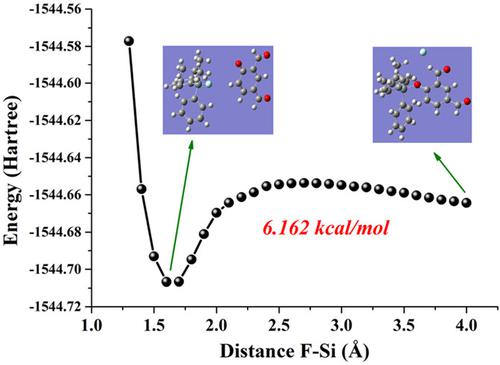当前位置:
X-MOL 学术
›
J. Chin. Chem. Soc.
›
论文详情
Our official English website, www.x-mol.net, welcomes your
feedback! (Note: you will need to create a separate account there.)
Theoretical insights into the fluoride anion response mechanism of a fluorescence chemosensor 4‐((tert‐butyldiphenylsilyl)oxy)isophthalaldehyde
Journal of the Chinese Chemical Society ( IF 1.6 ) Pub Date : 2019-06-21 , DOI: 10.1002/jccs.201900061 Xiaohan Du 1 , Xiaohui Yang 1 , Haiyan Gao 1 , Dapeng Yang 1, 2
Journal of the Chinese Chemical Society ( IF 1.6 ) Pub Date : 2019-06-21 , DOI: 10.1002/jccs.201900061 Xiaohan Du 1 , Xiaohui Yang 1 , Haiyan Gao 1 , Dapeng Yang 1, 2
Affiliation

|
It is well known that ions play important roles in our life sciences, and the detection of ions has attracted more and more attention. In this work, we focus on the sensing response mechanism of a novel fluoride chemosensor, 4‐((tert‐butyldiphenylsilyl)oxy)isophthalaldehyde (BIPA). Based on density functional theory and time‐dependent density functional theory methods, we clarify that fluoride anions could trigger the cleavage reaction of the Si‐O bond of BIPA in the ground state. And, the potential energy curve of desilylation process reveals the rapid response to fluoride anions. Comparing the binding energies between fluoride anions and other anions, we confirm that only the fluoride anions could be detected using the BIPA chemosensor in ethanol solvent. Considering the photo‐excitation process, we find the strong intramolecular charge transfer process for the S0 → S1 transition could explain the red shift of the absorption spectra of the BIPA system. This work not only clarifies the specific fluoride‐sensing mechanism, but also plays a role in facilitating designing and synthesizing of novel fluorescent sensors in future.
中文翻译:

荧光化学传感器4-((叔丁基二苯基甲硅烷基)氧基)间苯二甲醛的氟阴离子响应机理的理论见解
众所周知,离子在我们的生命科学中起着重要的作用,并且离子的检测已引起越来越多的关注。在这项工作中,我们专注于新型氟化物化学传感器4-((叔丁基二苯基甲硅烷基)氧基)间苯二甲醛(BIPA)的感测响应机制。基于密度泛函理论和随时间变化的密度泛函理论方法,我们阐明了氟阴离子可以触发基态BIPA的Si-O键裂解反应。并且,去甲硅烷基化过程的势能曲线揭示了对氟阴离子的快速响应。比较氟化物阴离子和其他阴离子之间的结合能,我们确认使用BIPA化学传感器在乙醇溶剂中只能检测到氟化物阴离子。考虑到光激发过程,0 →S 1跃迁可以解释BIPA系统吸收光谱的红移。这项工作不仅阐明了特定的氟化物传感机制,而且还在促进未来新型荧光传感器的设计和合成中发挥了作用。
更新日期:2019-06-21
中文翻译:

荧光化学传感器4-((叔丁基二苯基甲硅烷基)氧基)间苯二甲醛的氟阴离子响应机理的理论见解
众所周知,离子在我们的生命科学中起着重要的作用,并且离子的检测已引起越来越多的关注。在这项工作中,我们专注于新型氟化物化学传感器4-((叔丁基二苯基甲硅烷基)氧基)间苯二甲醛(BIPA)的感测响应机制。基于密度泛函理论和随时间变化的密度泛函理论方法,我们阐明了氟阴离子可以触发基态BIPA的Si-O键裂解反应。并且,去甲硅烷基化过程的势能曲线揭示了对氟阴离子的快速响应。比较氟化物阴离子和其他阴离子之间的结合能,我们确认使用BIPA化学传感器在乙醇溶剂中只能检测到氟化物阴离子。考虑到光激发过程,0 →S 1跃迁可以解释BIPA系统吸收光谱的红移。这项工作不仅阐明了特定的氟化物传感机制,而且还在促进未来新型荧光传感器的设计和合成中发挥了作用。






























 京公网安备 11010802027423号
京公网安备 11010802027423号